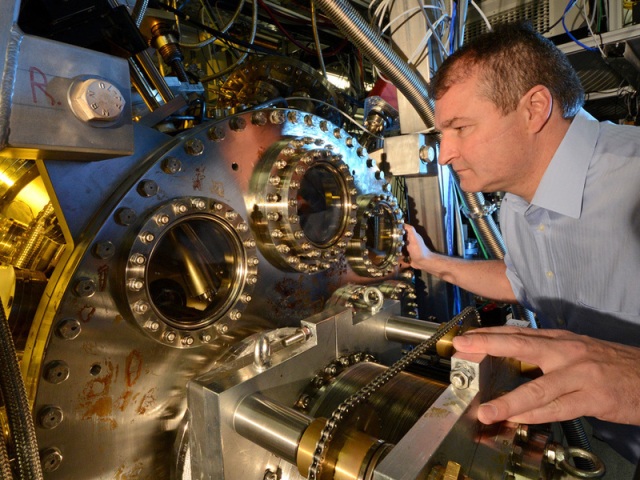Jan 22 2015

Electrons in sight: Reinhard Kienberger inspects an experiment at the attosecond beamline with which he and his colleagues study the motion of electrons. © Thorsten Naeser
Physicists from the Max Planck Institute of Quantum Optics and the Technische Universität München have determined the speed at which an electron races through a single layer of atoms of a crystal lattice.
A very short laser pulse was used by the researchers in order to time the speed of a moving electron. The measurements showed that an electron required 40 attoseconds to pass through a single layer of magnesium atoms. This knowledge will help researchers develop faster and smaller electronic components.
Electrons move within atoms with almost unimaginably short time dimensions. When light is used to excite the electrons, their quantum mechanical ‘location’ changes in attosecond time spans.
Reinhard Kienberger, a professor for laser and X-ray physics at the Technische Universität München and Max Planck Fellow at the Max Planck Institute of Quantum Optics, led the international team of researchers.
The team has measured the time taken by an electron to go through a single atomic layer. They observed that a tungsten crystal electron races through an atomic layer of magnesium in 40 attoseconds. The layer of magnesium atoms has a thickness of just a few billionths of a metre.
Scientists belonging to the Vienna University of Technology and the Ludwig-Maximilians-Universität München also took part in this study. For this experiment, a specific number of atomic layers of magnesium were applied to a tungsten crystal.
Two light pulses were then sent onto these samples. At extreme ultraviolet frequencies, the first light pulse lasted for approximately 450as. This light flash penetrated the material and made it to release one electron that it very near to the atomic nucleus of magnesium layers and also to the tungsten crystal that is below.
 © Christian Hackenberger
© Christian Hackenberger
After their release, the magnesium electron and the tungsten electron were made to go through the crystal to the surface. From this place, the electrons left the solid body.
The researchers found that tungsten crystal’s electrons could penetrate a maximum of four magnesium atom layers. The second laser pulse’s electric field affected the particles. This second laser pulse was an infrared wave that had a less than five femtosecond duration.
The length of the journeys of the magnesium electron and the tungsten electron differ and hence they reach the surface at different times.
Here, the second, infrared light pulse is experienced by them at different times. This would mean that the different strengths of the oscillating electric field would impact the electrons.
Based on this, the two particles get accelerated by varying degrees. This led to different energies in the electrons, and based on this energy difference, the researchers found out how long an electron needed for passing through an atomic layer.
The study provides knowledge about movement of electrons in the microcosm. The knowledge of how fast an electron moves from one location to another is also important for applications: “While a great many electrons move over distances which are still large in today’s transistors, for example, individual electrons could transmit a signal via nanostructures in the future,” says Reinhard Kienberger.
“This means that electronic devices, such as computers, could become several times faster and smaller.” For developing the required components, the researchers intend to acquire better knowledge about the travel of electrons in the very small distances in such electronic components.